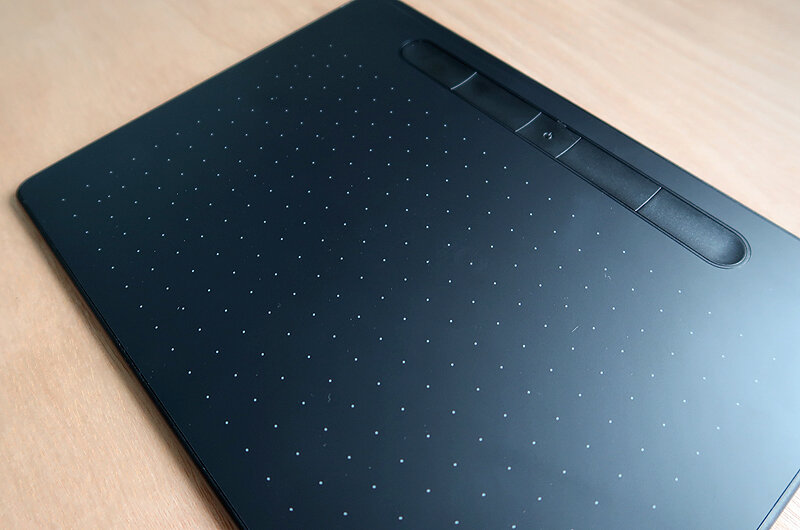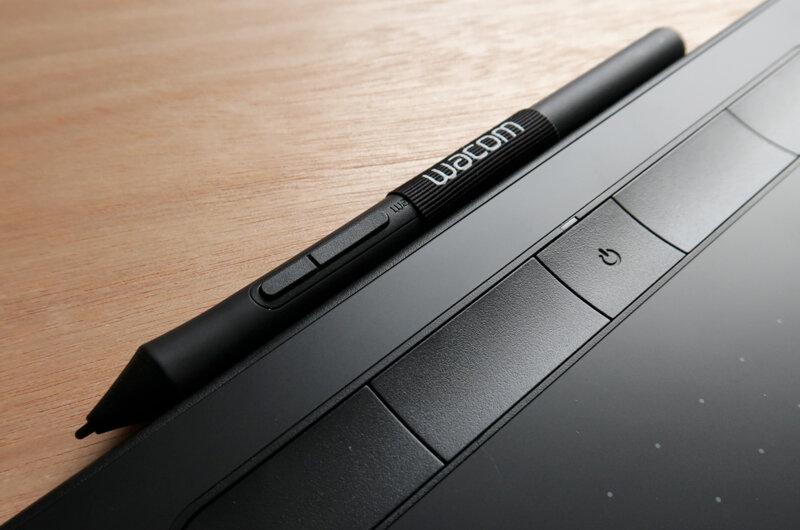Wacom Intuos Review
I remember when I started working in this industry. The thought of being able to use any sort of creative tablet felt like a distant dream, something way out of my reach. Back then they were expensive and could be quite large and heavy so were reserved for the top artists with a more flexible budget.
These days it seems that longing has progressed to the interactive display tablets, like the Cintiq’s. They are coveted by artists wanting the ability to draw directly on the screen while the humble tablet is almost seen as an inferior device.
The truth is that entry level tablets like the Intuos are more valuable than ever. They give emerging artists the freedom to draw, paint or even sculpt in a more natural way, allowing them to break free from the restrictions of a mouse, without parting with a huge chunk of money.
To test this, I put away my MobileStudioPro and decided to work on the Wacom Intuos for a while to see how far it could be pushed, and if it’s worth investing in.
So, could this be a worthy tablet for an artist on a limited budget?
Read on to find out…
Unboxing
The box the Intuos comes in is small, light and has a nice design on the front to catch your eye. You have all the information you need at your fingertips, including the size, colour and which type of creative tablet is included.
For this review I was testing the medium sized, Bluetooth version which came in black, but you can also choose from a small version with similar specifications or an even cheaper alternative that comes without Bluetooth. You can also opt for a different colour, like pistachio or berry, depending on your region, if you want something a little more stylish and personalised.
On the back you get a picture of the Intuos as well as the stylus. It also shows you the free software which you can download to get you started on your creative path. This includes Corel Painter Essentials 6 which is used for creating digital art. Corel Aftershot 3 for photo manipulation and editing and Clip Studio Paint Pro which is more geared towards comic art.
On opening the box you will find the tablet, the stylus and a USB cable. The cable is used for charging the Intuos as well as connecting it to a computer, which you will need to do to get started. It’s also almost five-foot-long which is a nice change when these days cables seem to be getting shorter and shorter, although if your using this primarily with Bluetooth the cable length isn’t really an issue.
In addition to these you get the usual leaflets which help you to get started and offer warranty and other technical information.
Setup
Getting started with the Intuos is very easy. With the included instructions, Wacom take you by the hand and guide you through the setup process.You first plug the tablet into your computer, be this a PC or a Mac, and then you go to www.wacom.com/start/intuos. Here the website takes over and continues to walk you through the installation, the next step being downloading and installing the Wacom drivers.
After a quick restart you are then presented with a new window which introduces you to the tablet and its various controls, which is handy for new users.
Once that’s done you are ready to go.One thing to note is its always worth charging the Intuos before you use it. The device I received wasn’t fully charged so I initially had trouble connecting to Bluetooth, but this was easily rectified.
The Tablet
The medium size tablet is roughly 10 by 8 inches, whereas the small version comes in at around 8 by 6 inches. They are both just 0.35 inches thick which makes them feel nice and compact, almost like an older iPad.
The active area on the medium tablet, which is the section of the surface you can draw on, is ten inches in diameter, so 75% of the actual tablet surface. Its important to point out that it is not touch sensitive, something I discovered when trying to pinch and zoom on it.
On first inspection the tablet feels sturdy and well made, which isn’t a surprise for a Wacom device. At only 250 grams It also feels light and compact, enough so that I could happily slide it into a laptop bag and take it out with me to meetings or if I fancied painting on the go.
The matt surface has a nice feel to it and offers a subtle grain as you run your fingers over it. On the base there are also four rubber feet which help to grip the desktop and stop the tablet sliding while in use.
Across the top you have the four Express Keys, which are fully customizable, as well as the power button. These are all recessed into the tablet making them double up as a rest for the stylus or a place to put it when you are away from your desk, safe in the knowledge that it won’t roll away.
In addition to the pen rest there’s also a tab on the top of the device which can be used to store the stylus when your traveling. Again, to save you losing it in the bottom of your bag.
The Stylus
The stylus which accompanies the Intuos is very familiar in design to other Wacom pens. Its battery free and offers a good range of pressure sensitivity, giving you 4096 levels. It also has two buttons on the barrel for you to configure to suit your own needs. Following in the footsteps of the ProPen 3D Wacom have also removed the eraser from the opposite end. For me this is a good move as I never used the eraser anyway, but for some this could be a deal breaker.
This time around Wacom have included the spare nibs in the stylus itself. You can unscrew the end to reveal them and use a specially designed tip to help remove the one in use, if you do it carefully that is. On more than one occasion I’ve been on my hands and knees searching for a nib who decided to flick out of the tip and across the room.
The stylus comes with a total of four standard nibs, including the one in the tip. You can of course buy additional felt or flex nibs, which change how the stylus feels as you use it.
When I initially pulled the stylus from the box, I was a little concerned. You see, I use a ProPen 3D every day, so I’m used to the size and weight of that, the stylus which comes with the Intuos is lighter and slimmer, so my initial thoughts were that Wacom had chosen to include a cheaper model to keep costs down.
After using it for a while I was pleasantly surprised by how it felt in my hand, so my initial concerns were unfounded.
Configuration
The amount of options available to any Wacom user is astounding, yet many people skip over them because setting them up can be time consuming or they are just unaware of them.
You have four Express Keys on the Intuos plus two buttons on the stylus and these are all configurable through the Wacom Desktop application.
You can set them up to mimic certain mouse clicks or even define frequently used keyboard shortcuts. More advanced features allow you to bring up a radial menu which is home to multiple commands as well as on screen controls, which again can be configured to suit your workflow.On top of this everything can be application dependant, so as you can see there are lots of options available to you.
The Tablet in Use
I’m fortunate enough to be able to use a MobileStudioPro which offers over 8,000 levels of pressure sensitivity, so if I’m honest I wasn’t expecting to get the same experience when using the Intuos.
I used it mainly with Photoshop, but I did also experiment briefly with ZBrush and a few other painting applications and what I found was a great painting experience. Yes, the sensitivity wasn’t the same, yet I wasn’t expecting it to be, but the 4096 levels offered me enough to work comfortably with.
The stylus felt good to hold and the buttons were in just the right place that I could easily use them with my index finger.
When moving the stylus across the surface of the Intuos I got a nice degree of feedback, making the experience feel much closer to that “pen on paper” feeling we all search for.With this being the medium sized tablet, I didn’t feel cramped or confined, instead I always had enough room to move around freely. As for the small version, I do feel that this could possibly be too small, and people may find they struggle after a while. With that said, it does depend on how often you will be using it and what you will be using it for.
At £89.99, or (£70 without Bluetooth), the small version is half the price of the medium, which is £179.99, so if you can cope with losing a few inches the smaller Intuos may be the more economical option.
Should You Invest?
If you’re a student or are just starting out on your digital art career path, it may seem overwhelming the amount of choice you have when it comes to creative tablets.
There’s much more competition these days, so why should you invest in a Wacom Intuos?
After spending some time with one I can happily recommend it to anyone. The build quality is good, it feels great to use and it is highly configurable. With the added bonus of Bluetooth connectivity, you get the freedom to work with the tablet anywhere and aren’t restricted by wires.
The only down sides I can see are the lack of tilt support, or any kind of touch controls, but for a tablet of this price range you could easily live without them.
Although Wacom supplied the Intuos for me to test, the opinions offered in this review are my own.













